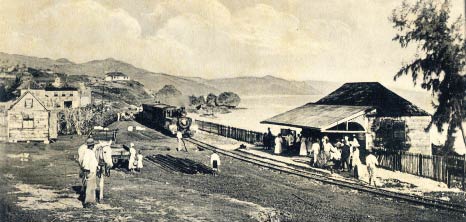|
The Barbados RailwayThe Barbados Railway is an interesting story in Barbados’ history. The first proposal to build a railway in Barbados came about in 1845 with a line envisioned to run between Bridgetown to the important trading town of Speightstown. However, by 1850 only a small amount of the capital had been raised and the project was stopped.
Construction BeginsWith funding in place the construction of the line began in 1877 on the 23rd of June. It is said that the construction process was a very slow process and there were many difficulties along the way with legal and financial problems.
By August 1883 the line had been reopened and all accounts of service reported that the passengers enjoyed the ride all the way to Belelplaine. Many of the initial problems appear to have been resolved and the train line was now ready for full operations.
Under New ManagementIn 1894 a new General Manager, Mr. Walter Merrivale, was appointed to the Railway system. One of his great innovations was the creation of the “Penny Train” carriages that were aimed at less affluent members of the society. It appears to be a success and attracted many patrons who would take outings on the train as weekend escapes to see the other side of the island in groups. Another use of the “Penny Trains” was to service people living in the outlying districts but needed to get to the city. The stops this train made were more in line with villages around the island and were early in the morning to facilitate people getting to work.
Twelve years later in 1986 the train service had taken a beating from the Atlantic oceans sea spray on its lines. There were reports that areas of the original train track were so eroded that major parts of the system would need major work done on it. After major storms in December 1986 large parts of the costal tracks were destroyed by wave action and had to be completely replaced. A full assessment of the equipment of the railway was ordered shortly afterwards and carried out. In many respects the equipment was also in bad shape and needed serious work done to it. With all these problems the railway ownership decided to turn to the experience of Mr. E.R Calthorp who ran successful train systems around the world. His initial assessment was that new rails needed to be laid and that he would change the gauge of the tracks to a smaller two feet and 6 inches. Within two years new tracks were laid and new locomotives and passengers carriages were purchased from the U.S.A. The railway was back in operation. This however was to be short-lived as the company ran out of funds and loss government subsidies. The line was closed in 1904 and liquidators were bought in to find a purchaser.
A New Company Is Formed
In 1905 a new company called The Barbados Light Railway Company Limited was formed and began service. The new company also decided to extend the rail system by offering a branch from Carrington to the Crane. While not much is known about this branch it was noted that the Cranes’ hotel offered transport from Bush Park where the train stopped to the hotel. By 1906 the company was heading into financial difficulty again as passenger traffic was minimal and the company operated off the profits of moving mainly freight. By 1914 further government subsidies that the new company enjoyed were again cut and the company was closed and put into liquidation.
Government Takes Over RailwayIn 1916 the Government of Barbados took over the Railway Service. The first thing they did was to begin the upgrading of the present system then start the service up again. First only moving freight traffic then later in the 1917 moving passenger traffic again. During the ensuing years the railway system continued to decay. Even after the purchase of a new train and the refurbishment of older ones the railway line still fell into disrepair and had many problems including derailments. It was also noted that the buildings in Bridgetown were also in disrepair. There was a feeling by 1930 that the rail system in Barbados may not have been needed any longer and that the cost associated with maintaining and rebuilding far outweighed the benefits of developing a new and better way of transporting person and freight from the rural and factories of the country to Bridgetown.
|




 With the great success of the train systems being built across the United Kingdom it was again felt that a train in Barbados would be very useful to move sugar from the various factories to the city as well as people around the island. Again in 1873 proposals were being made to build a track in Barbados but this time from the city Bridgetown to the parish of
With the great success of the train systems being built across the United Kingdom it was again felt that a train in Barbados would be very useful to move sugar from the various factories to the city as well as people around the island. Again in 1873 proposals were being made to build a track in Barbados but this time from the city Bridgetown to the parish of  By 1881 some four years after construction began a driver and foreman from the United Kingdom were hired to traine local staff early in the year. By October that same year the line was opened with limited service to Carrington only. On Thursday, 20th of October 1881 the line was officially opened offering trips to a large number of people who were excited about the novelty of this kind of
By 1881 some four years after construction began a driver and foreman from the United Kingdom were hired to traine local staff early in the year. By October that same year the line was opened with limited service to Carrington only. On Thursday, 20th of October 1881 the line was officially opened offering trips to a large number of people who were excited about the novelty of this kind of  The early years of the train system appears to have been very successful with high levels of sugar, freight and passenger traffic being recorded. While these early years were successful the owners of the railway network never seemed to be investing back into the business as it is reported that by the 1890’s the company ran in to problems where routine maintenance was not being carried out due to lack of funds. Also because of the high level of corrosion on the
The early years of the train system appears to have been very successful with high levels of sugar, freight and passenger traffic being recorded. While these early years were successful the owners of the railway network never seemed to be investing back into the business as it is reported that by the 1890’s the company ran in to problems where routine maintenance was not being carried out due to lack of funds. Also because of the high level of corrosion on the 
 By 1934 the service for passengers was discontinued due to safety factors. Though freight traffic continued to be moved on the line, the inevitable was clearly seen. The track had to either be fully refurbished and new equipment purchased or close. The decision was taken and on the 12th of October 1937 the Railway system was closed down in Barbados. Soon afterwards the government sold the rights to the steel and tracks were removed in 1938. Many parts were sold to overseas interest as well as locally. One of the remnants that can still be spotted in rare areas around the island of the railway system is the use of tracks as telephone poles. While many have been removed there are still a few areas where you might be able to see a newer pole being anchored by a piece of steel that would have once been the old tracks of the railway system.
By 1934 the service for passengers was discontinued due to safety factors. Though freight traffic continued to be moved on the line, the inevitable was clearly seen. The track had to either be fully refurbished and new equipment purchased or close. The decision was taken and on the 12th of October 1937 the Railway system was closed down in Barbados. Soon afterwards the government sold the rights to the steel and tracks were removed in 1938. Many parts were sold to overseas interest as well as locally. One of the remnants that can still be spotted in rare areas around the island of the railway system is the use of tracks as telephone poles. While many have been removed there are still a few areas where you might be able to see a newer pole being anchored by a piece of steel that would have once been the old tracks of the railway system.